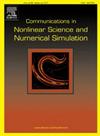部分退化加权网络上登革热传播动力学分析
IF 3.8
2区 数学
Q1 MATHEMATICS, APPLIED
Communications in Nonlinear Science and Numerical Simulation
Pub Date : 2024-11-30
DOI:10.1016/j.cnsns.2024.108495
引用次数: 0
摘要
本文提出了一种部分退化的登革热传播加权网络动力学模型,以加权图拉普拉斯扩散表征登革热传播的空间动态。首先,建立了在有限加权网络上定义的一般反应扩散微分方程的比较原理。其次,建立了模型解的适定性。在此基础上,通过上下解法和构造Lyapunov函数,研究了无病平衡点和地方病平衡点的稳定性。此外,还证明了模型的均匀持久性。最后,我们将广义加权图应用于Watts-Strogatz网络,并给出了几个数值例子来验证理论结果,得到了一些有趣的结论:即使模型中蚊子种群方程中没有扩散项,但感染人群和感染蚊子种群的峰值数量依赖于节点度。本文章由计算机程序翻译,如有差异,请以英文原文为准。
Analysis of transmission dynamics of dengue fever on a partially degenerated weighted network
In this paper, we propose a partially degenerated weighted network dynamical model for dengue fever transmission to study its spatial transmission dynamics, in which population mobility are characterized by the weighted graph Laplacian diffusion. Firstly, we establish the comparison principle for general reaction–diffusion differential equations defined on finite weighted network. Next, the well-posedness of solutions is established for the model. Then the basic reproduction number of the model is calculated, and then the stability of disease-free and endemic equilibria is investigated by means of the upper and lower solutions method and the construction of Lyapunov function. Furthermore, the uniform persistence of the model also is demonstrated. Finally, we apply the generalized weighted graph to the Watts–Strogatz network and present several numerical examples to verify theoretical results and obtain some interesting conclusions: the peak numbers of infected human population and infected mosquito populations depending on the node degree, even though the equations for the mosquito population in the model has no diffusion term.
求助全文
通过发布文献求助,成功后即可免费获取论文全文。
去求助
来源期刊

Communications in Nonlinear Science and Numerical Simulation
MATHEMATICS, APPLIED-MATHEMATICS, INTERDISCIPLINARY APPLICATIONS
CiteScore
6.80
自引率
7.70%
发文量
378
审稿时长
78 days
期刊介绍:
The journal publishes original research findings on experimental observation, mathematical modeling, theoretical analysis and numerical simulation, for more accurate description, better prediction or novel application, of nonlinear phenomena in science and engineering. It offers a venue for researchers to make rapid exchange of ideas and techniques in nonlinear science and complexity.
The submission of manuscripts with cross-disciplinary approaches in nonlinear science and complexity is particularly encouraged.
Topics of interest:
Nonlinear differential or delay equations, Lie group analysis and asymptotic methods, Discontinuous systems, Fractals, Fractional calculus and dynamics, Nonlinear effects in quantum mechanics, Nonlinear stochastic processes, Experimental nonlinear science, Time-series and signal analysis, Computational methods and simulations in nonlinear science and engineering, Control of dynamical systems, Synchronization, Lyapunov analysis, High-dimensional chaos and turbulence, Chaos in Hamiltonian systems, Integrable systems and solitons, Collective behavior in many-body systems, Biological physics and networks, Nonlinear mechanical systems, Complex systems and complexity.
No length limitation for contributions is set, but only concisely written manuscripts are published. Brief papers are published on the basis of Rapid Communications. Discussions of previously published papers are welcome.
 求助内容:
求助内容: 应助结果提醒方式:
应助结果提醒方式:


